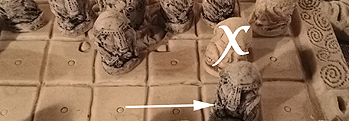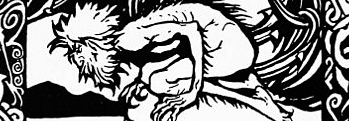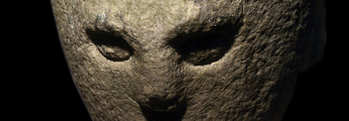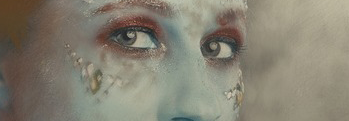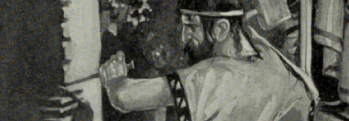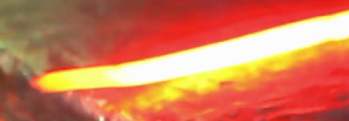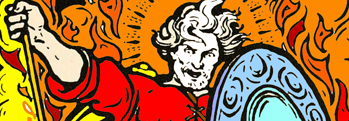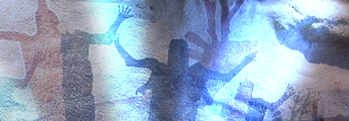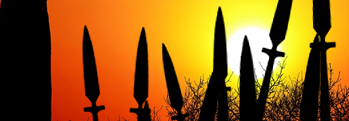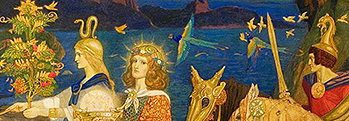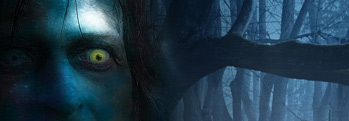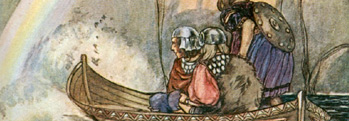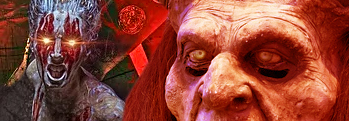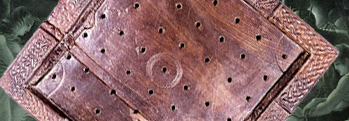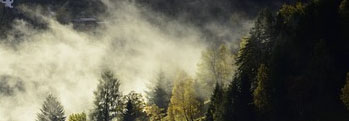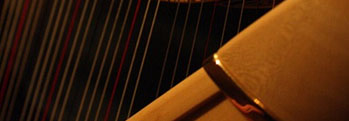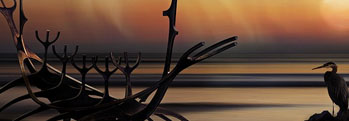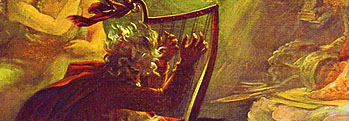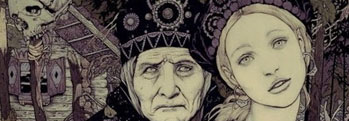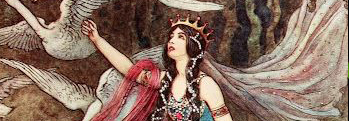The Dream of Aengus
Irish and Celtic myths and legends, Irish folklore and Irish fairy tales from the Mythological Cycle
True love comes in many forms
 It was a warm and balmy summer's night, heavy with the fragrances of heather and honeysuckle, when Aengus, son of Dagda, awoke to find a beautiful young woman approaching him where he had slept. He was immediately taken with her grace and elegance, and his heart yearned for her, but when he tried to speak, she vanished!
It was a warm and balmy summer's night, heavy with the fragrances of heather and honeysuckle, when Aengus, son of Dagda, awoke to find a beautiful young woman approaching him where he had slept. He was immediately taken with her grace and elegance, and his heart yearned for her, but when he tried to speak, she vanished!
He stayed in his bed until morning, but sleep was far from his mind as he wondered greatly who she had been, this mysterious midnight visitor. Not a bite of food did he eat that day, and his fevered brow was furrowed with thoughts of her.
He didn't sleep that night either, but stayed awake until she came to him. No words did he speak, for fear she might vanish like a reflection on the waters again. She brought forth a timpán, which was a kind of lyre used in ancient Ireland, and played sweet music to soothe him until he slept soundly.
A full year passed in this way, and it was only sicker and sicker he got with each nightly visit! He was deep in love with the young woman but told nobody what ailed him. The healers of Eriu gathered and prodded him and poked him, they gave him herbal remedies and tinctures of rare substances, but nothing seemed to work.
At last they called for Fingen, who was the healer of Cond, and he saw immediately where the problem lay, just as he could tell from the smoke rising from a chimney-hole how many were sick inside a house, and what their sicknesses were.
Fingen took Aengus aside and confided that he knew what ailed him – love in absence! Aengus broke down then and confessed the whole business, so Fingen nodded and decided the wisest course of action would be to send for Boand, the mother of Aengus.
Well she wasted no time in arriving, and Fingen explained what had been going on.
“It would be best for you to tend him,” he said, “and for you to search throughout Eriu until the figure that has been visiting Aengus is found.”
For a full year thereafter the queen's warriors and wise folk searched high and low throughout Eriu, but in the end no sign of her was found, so they called next for the Dagda, who had knowledge of many things hidden and lost.
When he arrived Fingen told him everything, and said to him
“It is right that you help him, for his death would be a pity. Love in absence has overcome him, and no help for it has been found.”
“Why tell me?” asked the Dagda, “My knowledge is no greater than yours!”
“Indeed it is greater,” replied Ferdne, “for you are the king of all of the Sidhe, the people of the mounds, of Eriu. Will you send messengers to the spirit Bodb who rules the Sidhe of Mumu, and who knows all the deep ways?”
Fast fairy riders were sent to the Bodb in Mumu, which we today know as Munster, and they were made welcome. When they heard the trouble that afflicted Aengus, they wasted no time in agreeing to help find this young lady, and the Bodb assured them he would search for a full year to be certain.
At the end of the year, Bodb's people went to him at his house in Sídh ar Femuin and said
“We made a circuit of Eriu, and we found the girl at Loch Béal Dragún, the Lake of the Dragon's Mouth in Cruit Cliach, the Harps of Cliach.”
Messengers went to the Dagda, who rejoiced at the news, and they asked him to bring Aengus back with them to be certain they had the right woman.
Aengus was brought to Sidh ar Femuin in a bronze-studded chariot and made welcome, a great feast was laid out for his arrival, laden with every kind of delicacy and wholesome food to restore his strength.
After that, the Bodb said to Aengus “Let us go to see if you recognise the girl. You may look upon her, but be warned that it is not in my power to give her to you!”
They travelled a ways until they reached the lake, and there they saw thrice times fifty young girls, and among them was none other than the lady who had stolen the heart of Aengus! The other girls were no taller than her shoulders, and they were linked in pairs by silver chains. Only Aengus' girl wore a silver necklace and a chain of polished, glimmering gold.
“Is that her?” inquired the Bodb.
“It is,” confirmed Aengus.
 “That is the end of it then,” said the Bodb.
“That is the end of it then,” said the Bodb.
“Never,” said Aengus, “Who is she?”
“Her name is Cáer Ibormeith daughter of Ethal Anbúail from Sídh Uamuin in the kingdom of Connachta,” said the Bodb.
So Aengus returned to his own land and brought the Bodb with him, and they came before the Dagda to tell him their news – how the girl's form and appearance were just as Aengus had seen, and they spoke her name and those of her father and grandfather.
“A pity that we cannot get her,” said the Dagda.
“What you should do is go to Ailill and Medb, for the girl is in their territory,” said Bodb.
So the Dagda went to Connachta and brought with him a great entourage, three score beautiful chariots, many riders and followers. They were made welcome and spent a full week feasting and drinking.
Then the King asked the Dagda, “Why have you come to visit, arrayed in such panoply?”
“There is a girl in your territory,” said the Dagda, “and my son has fallen in love with her. He will not eat and wastes away while he dreams of her. I have come to see if you will give her to me. She is the daughter of Ethal Anbúail.”
“We do not have the power to give her to you,” said Ailill and Medb.
“Then the best thing would be to have the King of that mound called here,” said the Dagda.
Ailill's herald went to Ethal Anbúail and said “Ailill and Medb require that you come and speak with them.”
“I will not come,” Ethal said, “and I will not give my daughter to the son of the Dagda.”
The herald repeated this to Ailill, saying “He knows why he has been summoned, and he will not come.”
“No matter,” said Ailill, “for he will come, and the heads of his warriors with him!”
As you can tell, even among fairies it is no small thing to defy a king!
Ailill's household and the Dagda's warriors rose up against the sidh and destroyed it, and from the ruins they brought out three score bloody heads and the King in chains, from where he was brought to Crúacha.
King Ailill said then to Ethal Anbúail “Give your daughter to the son of the Dagdae!”
“I cannot,” he replied, “for her power is greater than mine.”
“What great power does she have?” Ailill asked in bafflement.
“Being in the form of a bird each day of one year and in human form each day of the following year,” Ethal said.
“Which year will she be in the shape of a bird?” Ailill asked with a calculating look.
“It is not for me to reveal that,” Ethal replied.
“It's your head,” shrugged said Ailill, lifting his razor sharp wide sword.
“I will conceal it no longer, then, but will tell you, since you are so obstinate,” said Ethal, “next Samhain she will be in the form of a bird at Loch Béal Dragún, and beautiful birds will be seen with her, thrice fifties of swans about her.”
Peace and friendship were made between Ailill and Ethal and the Dagda, then, and the Dagda waved farewell and went to his house to tell Aengus all the doings.
“Go next Samhain, when the worlds are thin, to Loch Béal Dragún,” he said, “and call her to you there.”
Aengus went to Loch Béal Dragún, which was also called Lough Béal Seod, the Lake of the Jewel Mouth, where he saw the three times fifty white birds with silver chains, and golden hair about their heads, and there were no more beautiful birds in all of Eriu. Aengus was in human form at the edge of the lake, and he called to the girl, saying
 “Come and speak with me, Cáer!”
“Come and speak with me, Cáer!”
“Who is calling to me?” asked Cáer.
“Aengus is calling,” he replied, “he whom you have visited many nights and played sweet music to.”
“I will come,” she said, “if you can promise me that I may return to the water.”
“You have my promise,” he said.
She went to him, then and he put his arms round her, and they slept in the form of swans upon the waters until they had circled the lake three times, and that is how he kept his promise. They left in the form of two great swans and flew to Brugh mac Óg, and there they sang until the people inside fell asleep for three days and three nights.
The girl remained with Aengus forever after, and this is how the friendship between Ailill and Medb and Aengus arose, and this is why Aengus took three hundred warriors of the mounds to the cattle raid of Cúailnge when that time came.
Loch Béal Dragún, also known as Lough Béal Seod, and today called Lough Muskry can be found on the map below!
More Stories from the Mythological Cycle
The Irish love music, and it has long been said that the Irish race lived and breathed melodies, liable to burst into song at the drop of a hat. Few realise how far back the Irish musical tradition goes however - at least as far as we know! Some of the earliest musical instruments which have been uncovered date from the Irish Bronze Age, in thos ... [more]
During the Irish bronze age, the working of gold reached heights never before seen or dreamed of. Goldsmiths fashioned the soft, luminous metal into intricate forms resembling cloth, cord, the rising and falling hills of Ireland, and many other striking designs. Among their most famous and beautiful creations were the astonishing gold collars, one ... [more]
The warm, glimmering golden glow of amber, or ómra in Irish, has held deep fascination for people since the Neolithic and probably long before that. Its rich, flowing contours capture and refract the sun and firelight with equal facility, and it may have been one of the first gems worked by human hands. Its beauty has inspired enterprise and ... [more]
This stunning battle-shield, cast from golden-hued shimmering bronze, was originally made during the bronze age. It is one of about two dozen similar shields of varying sizes found across the Irish Isles, and dates back to around 1000 BC. Measuring around 71cm across, it began life as a flat sheet of bronze, which was then hammered over rounded ... [more]
The extraordinary bronze age Irish axehead is remarkable not only for the decorations adorning the axe itself, but also for the carry-pouch or sheath discovered along with it when it was found four meters deep in a peat bog in Brockagh, County Kildare. It is very unusual for any organic material to have survived thousands of years, but the unique c ... [more]
The Lurgan Canoe is one of the earliest boats found in Ireland, dating back four and a half thousand years, made from a single mighty oak tree felled when the first metalworkers began to arrive. This was a time of upheaval, mystery, magic, and wonder, old orders tottering and collapsing, the end of the age of the God-Kings of Ireland with their pon ... [more]
We are delighted to be able to present to you the rules of Fidchell, the Irish game of kings! This game can be purchased, but it's easy to get started and try it out for yourself. All you need is a 7 x 7 board, which can be squares or pins marked out - even on paper - 16 white or attacker pieces, a king piece, and 8 darker-coloured defender pie ... [more]
Times were hard in Ireland not so long ago, and harder yet they were before that – many’s the family was cast out of their houses for being unable to pay their rent! One such was poor Finian O’Toole, the kindly father of nine children who found himself evicted by the cruel English landlord in the parish of Kilmoe. Now it was th ... [more]
There is a tale, one of the oldest stories among the many very ancient stories of Ireland, of a man who returned to life as a man thousands of years after he first walked the earth. His legend was found in an eleventh century manuscript called Lebor na hUidre, which means The Book of Dun Cow, and it was written there by the followers of an early ... [more]
It’s a not uncommon belief that the women of Ireland in the ancient days were quiet and kept to themselves, letting the men do all the great deeds and win all the fame – but nothing could be further from the truth! From that day to this Irish women were and remain wild and fearless, willing to go to lengths as great as any man for victo ... [more]
Of great renown are the feats and deeds of the ancient heroes of Ireland, and still to this day they echo through our legends where such tales are told. But of scarce less fame were the weapons they bore, implements of glory and terror, bound to ancient spirits and clasping lightning within their shimmering length, wielded with scarcely imaginable ... [more]
The Tuatha De Danans By the force of potent spells and wicked magic, And conjurations horrible to hear, Could set the ministers of hell at work, And raise a slaughtered army from the earth, And make them live, and breathe, and fight again. So it was written in Keating's General History of Ireland, considered by many to be the definitive ... [more]
Her name was Clíona or Clíodhna and she was one of the most beautiful women of the Tuatha Dé Danann, that vanished sorcerous race whose legends echo still from one end of Ireland to the other. Some even say she was the most beautiful woman in the world, and she was worshipped as a goddess by the pagans of Ireland who followed t ... [more]
Many are the tales told of Lugh, the mightiest king of that ancient and mystical sorcerer race of Ireland, the Tuatha Dé Danann, but only one is told of his death. Now Lugh, lord of many warriors, had four wives, which back in those days wasn’t too unusual, and their names were Echtach, daughter of white-toothed Dagda, Englec, Ná ... [more]
Just as happens today, people in ancient Ireland had legal disputes and complaints they would bring before their courts, and the judge or king would try to make sense of what had happened and hand down a fair decision. But also just as happens today, there were situations where it was one person’s word against another, or there wasn’ ... [more]
The old stories of Ireland, some of the oldest in the world, tell of great ancients – almost immortals! – whose span of life stretched many thousands of years. Legends tell of their spirits passing from one body to the next, or upon occasion, staying in the one body for millennia, watching the tides of man and beast come and go. Such ... [more]
One of the chiefest and most powerful kings among the mystical Tuatha Dé Dannan was the one called Dagda, or Dagda Mór, which means “of shining skills”. He had other names too, such as Eochu the horseman, Ruad Rofhessa, lord of great knowledge, Dáire the fertile one and Aed, he of the fiery temper. Others yet called ... [more]
The Irish Brehon law codes are said to be the earliest fully developed legal system in Europe, but long before the Brehons were laid down there were earlier laws and all were subject to them, from the lowest to the highest! Women could hold their own property, were not themselves considered property, and could seek an education and improve their ... [more]
No tale of ancient Ireland could be complete without mentioning the Fomorians, dreaded foes of the Tuatha Dé Danann and all who came to conquer Ireland. The meaning of their name is debated even today, although most agree that the first part, fó, means “from below” or “nether” and the latter part means “t ... [more]
Many of the oldest records of Irish mythology and legend, which you might truthfully say are a history of prehistory, tell that the first people to arrive in Ireland were led by the lady Cessair when she fled to this land to escape the coming flood. The idols which had whispered through veils of midnight smoke that Ireland was a land untouched by p ... [more]
Throughout the old stories of Ireland are scattered mentions, and sometimes even descriptions, of some of the spells and rites used by both the Tuatha Dé Danann and those who came after them, the Gaels or Milesians, as they are sometimes known. Tales of these wondrous and mysterious feats of sorcerous skill may seem strange to us, but to the ... [more]
It was a warm and balmy summer's night, heavy with the fragrances of heather and honeysuckle, when Aengus, son of Dagda, awoke to find a beautiful young woman approaching him where he had slept. He was immediately taken with her grace and elegance, and his heart yearned for her, but when he tried to speak, she vanished! He stayed in his bed ... [more]
The river Barrow, like many rivers in Ireland, was given its name in ancient times. Few now know it once had another and very different name however, for it was when Dian Cécht walked the world, the healer of the Tuatha De Danann, that this river was first named! Dian Cécht, whose name meant swift power or swift potion, depending o ... [more]
A thousand years before the Olympic games were founded, the Tuatha De Dannan had arrived in Ireland and defeated the Fir Bolg, establishing their place on the Emerald Isle. The mighty queen Tailtiu had married Eochaid mac Eirc of the Fir Bolg, but he was killed during the invasion of Ireland by the Tuatha, so the leader of the invaders took her for ... [more]
In ancient times the Gaels would hold great festivals at different seasons of the year, such as the Tailteann Games, Tlachtga, Raigne and Lughnasadh, and it was at the beginning of August, every three years, that the festival of Carmun would be held during the festival of Lugh. Mighty were the celebrations held, with the racing of horses and the ... [more]
Long ago it was the time of the Tuatha De Danann in Ireland, and they were troubled by strife from beyond the Emerald Isle and within it. One of their mightiest warriors whose name was Lugh of the Long Hand heard that their demonic enemies from the sea, the Fomorians, had landed at Eas Dara, so he hopped up on Aonbharr, a horse which could gallop a ... [more]
Some of the most ancient Irish myths and legends tell of the Bocanachs and the Bananachs, known to the people of Ireland as fierce spirits of the air that were drawn to scenes of battle and bloodshed. Whenever armies gathered to test their might, the sky overhead would be filled with shrieking demons dancing to the sounds of swords clashing and blo ... [more]
Woven through many Irish stories, myths and legends is the ancient game of Fidchell, which means “wisdom of the wood”. It's said that it was invented by none other than Lugh of the Tuatha De Dannan, and predates chess by many centuries. Fidchell held a central role in the celebrations of Lugh, and at Samhain festivities as well, ... [more]
Well known is the ancient tale of the Children of Lir, and how two of the three of Bodb Dearg's daughters by Oilell of Aran married Lir to keep the peace in Ireland, between the rival chieftains of the Tuatha De Dannan. But less well known perhaps is the story of the daughter of the Bodb and one of her admirers, Cliach the Harpist. Cliach pl ... [more]
After the second battle of Moy Tura, Nuada the High King of the Tuatha De Danann was grievously injured, and as it was the law among their people that a king must be whole of body, Dagda Mór took his place. Mighty Dagda, of whom the ballads are sung, he was called the father of the Tuatha, the lord of knowledge, the many-skilled, th ... [more]
It is in the nature of fairytales and legends passed down from generation to generation that they might sometimes change and shift to fit the lives of the people of the time, and the more mysterious the figure the more legends accrue to it! And so it is with Donn of the Dead, king of the dead at the red tower of the dead, whose three sons cried &ld ... [more]
It was at the dawning of the world when the fair folk walked in broad daylight as bold as you and I, before the coming of the Milesians with their bitter iron blades and earthen ways, it was the time when magic was wrought and druidry had power, when heroes gave battle to gods and the titanic children of Seth still troubled the dreams of Heaven, it ... [more]
The raven has long been an omen of ill-tidings around the world, bearer of bad news and warnings, but in Ireland it was known once as a servant of the fairy Morrigan, or the raven was herself in person! She it was whose name meant the Great or Ghost Queen, from the old words for fear and greatness. Some will tell you earnestly that she was a god ... [more]
Long ago, in the time of the Tuatha Dé Dannan, one of their number became the high king of all Ireland, and his name was Eochaid Ollathair. He was a powerful magician of that sorcerous race, and by his workings he could change the weather and ensure the harvest was plentiful, as well as many other things. His wealth was vast and he was mu ... [more]
It was in the time of legends and heroes, when the Tuatha Dé Dannan had determined to go into their deep halls beneath the hills and mountains of Éireann the green, that the Dagda mór had fallen at the second battle of Moy Tura. With his slaying a new leader had to be elected and that was decided by the Tuatha to be the Red Cro ... [more]
And so it was when dragons still flew and champions walked the earth that the men of the Fir Bolg had lordship over all of Ireland. They had left Ireland centuries before due to the violence and heavy tribute demanded by the Fomorians, travelling far and wide until they came to the distant land of Greece. Although they made agreement and treaty ... [more]










